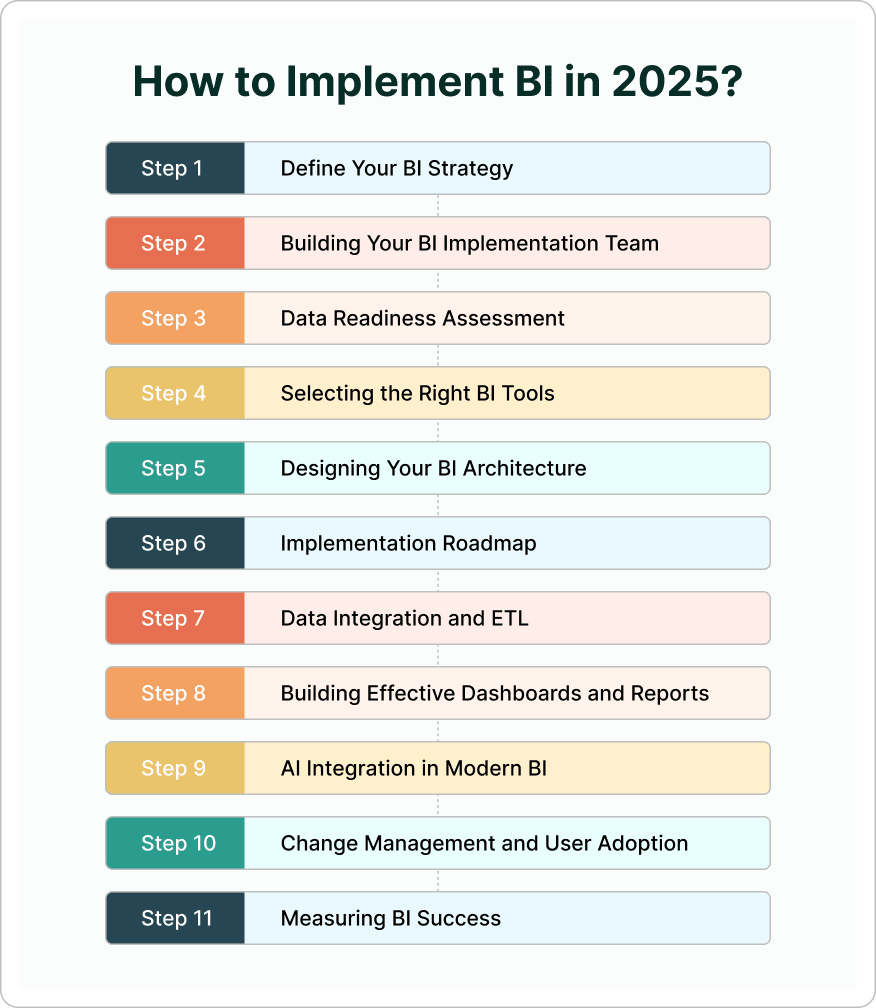In today’s data-driven business landscape, implementing robust business intelligence solutions has become essential for sustainable growth. Check out our detailed BI strategy framework to complement this implementation guide.
If you’re just getting started with data analytics, our introduction to business analytics covers all the fundamentals. For enterprises dealing with massive datasets, explore our big data analytics solutions to maximize your analytical capabilities.
Introduction: Why Business Intelligence Matters in 2025
Business Intelligence (BI) is no longer a competitive advantage – it’s a necessity. Organizations that harness BI effectively transform raw data into strategic insights that drive smarter decisions and improved performance.
The stakes are higher in 2025. With exponential data growth and tighter competition, companies without strong BI capabilities risk falling behind. Modern BI systems integrate AI, machine learning, and real-time analytics to provide unprecedented insights.
What is Business Intelligence in 2025?
Business intelligence encompasses technologies and practices that transform raw data into actionable business insights. It’s the bridge between your data and informed decision-making.
Modern BI goes beyond static reports. Today’s BI systems incorporate:
- Data integration from diverse sources
- Advanced analytics for deeper insights
- Interactive visualizations that make data accessible
- AI-powered capabilities that identify patterns humans might miss
The real power of modern BI lies in its ability to democratize data. Self-service tools enable users across organizations to access insights without technical expertise.

Step 1: Define Your BI Strategy
Successful BI Strategy implementation begins with a clear strategy. Your strategy must align with specific business objectives rather than implementing technology for its own sake.
Start by answering these critical questions:
- What business challenges are you trying to solve?
- Which KPIs will measure success?
- Who needs access to what data?
- What decisions will be driven by BI insights?
Example KPIs to consider:
- Revenue growth attributable to BI insights
- Time saved in reporting processes
- User adoption rates
- Data-driven decisions percentage
- Securing Executive Sponsorship
Securing Executive Sponsorship
Executive buy-in is crucial for BI success. Your champion should understand both the technical aspects and business benefits of the implementation.
Strong leadership support helps overcome resistance to change and ensures adequate resources. Make sure to quantify potential ROI when presenting to executives.
Step 2: Building Your BI Implementation Team
BI implementation requires diverse expertise. Your ideal team includes:
- BI Project Manager: Oversees the entire implementation
- Data Engineers: Handle ETL processes and data pipelines
- BI Developers: Build dashboards and reports
- Business Analysts: Translate business needs into technical requirements
- Data Governance Specialist: Ensures data quality and compliance
- End-user Representatives: Provide feedback throughout the process
Cross-functional collaboration is essential. IT cannot deliver effective BI in isolation from business users.
Step 3: Data Readiness Assessment
Data quality makes or breaks your BI initiative. Before selecting tools, audit your data landscape:
- Identify data sources across your organization
- Assess data quality issues (completeness, accuracy, consistency)
- Document data flows between systems
- Establish data governance frameworks
Organizations often underestimate the effort required for data preparation. According to Harvard Business Review, data scientists spend 80% of their time cleaning and preparing data.
Step 4: Selecting the Right BI Tools
The business intelligence tools market offers numerous options in 2025. Your selection should match your specific needs rather than following trends.
Key Considerations for Tool Selection:
- Scalability: Will it handle growing data volumes?
- User-friendliness: How steep is the learning curve?
- Integration capabilities: Does it connect with your existing systems?
- Total cost of ownership: Beyond purchase price, consider implementation and maintenance costs
- AI capabilities: Does it offer predictive analytics and machine learning?
- Mobile support: Can users access insights on any device?
Popular BI Tools in 2025:
- Microsoft Power BI: Excels in Microsoft ecosystem integration
- Tableau: Known for powerful visualizations
- Qlik Sense: Strong in associative analytics
- Looker (Google): Cloud-native with robust modeling
- ThoughtSpot: Leader in search and AI-driven analytics
Each tool has strengths and limitations. Many organizations use multiple tools for different use cases.
Step 5: Designing Your BI Architecture
A solid architecture provides the foundation for scalable, sustainable business intelligence strategy. Key components include:
- Data Sources: Internal systems, external feeds, cloud applications
- Data Integration Layer: ETL/ELT processes, data pipelines
- Data Storage: Data warehouse, data lake, or hybrid approach
- Analytics Layer: BI tools, machine learning models
- Presentation Layer: Dashboards, reports, embedded analytics
Step 6: Implementation Roadmap
Successful BI implementation follows a phased approach:
- Set up data warehouse/lake infrastructure
- Establish data pipelines for critical sources
- Implement data governance processes
- Deploy basic dashboards for key metrics
- Integrate additional data sources
- Develop advanced analytics models
- Roll out self-service capabilities to power users
- Implement data quality monitoring
- Deploy AI and predictive capabilities
- Embed analytics into operational systems
- Implement real-time data processing
- Enhance mobile access
Pro tip: Start with high-impact, achievable wins to build momentum and demonstrate value.
Step 7: Data Integration and ETL
The backbone of any BI solution is reliable data integration. Modern ETL (Extract, Transform, Load) processes should be:
- Automated: Minimal manual intervention
- Monitored: Alert systems for failures
- Documented: Clear lineage for compliance
- Scalable: Handles growing data volumes
Step 8: Building Effective Dashboards and Reports
The presentation layer is where business intelligence analytics delivers tangible value. Effective dashboards should:
- Answer specific business questions
- Present information in context
- Allow intuitive exploration
- Highlight exceptions and anomalies
- Drive action, not just awareness
Dashboard Design Best Practices:
- Start with user needs, not available data
- Use appropriate visualizations for each metric
- Apply consistent formatting and terminology
- Incorporate benchmarks and targets
- Avoid excessive detail on main views
Remember: The best dashboard is one that gets used regularly to inform decisions.
Step 9: AI Integration in Modern BI
AI for business intelligence represents the cutting edge of analytics in 2025. Modern systems leverage:
- Natural Language Processing: For conversational queries
- Machine Learning: For predictive insights
- Automated Insights: To highlight significant patterns
- Anomaly Detection: To identify outliers automatically
Organizations implementing AI-enhanced BI report 40% faster insight discovery compared to traditional analytics.
- Begin with clean, well-structured data
- Identify specific use cases with measurable value
- Start with vendor-provided AI capabilities
- Build internal AI expertise gradually
- Continuously evaluate AI model performance
Step 10: Change Management and User Adoption
Technology is only half the equation. BI implementation success depends on people actually using the system.
- Tiered Training Programs: Tailored to different user roles
- Champions Network: Power users who advocate for the system
- Quick Wins: Showcase immediate value to generate excitement
- Continuous Feedback Loops: Regularly gather and address user input
- Executive Dashboards: Get leadership using the system visibly
Step 11: Measuring BI Success
How do you know if your BI implementation is delivering value? Establish metrics in these categories:
- System performance and reliability
- Data refresh frequency and accuracy
- User access patterns
- Decision time reduction
- Cost savings from automation
- Revenue impact of data-driven decisions
- Adoption rates across departments
- User satisfaction scores
- Self-service report creation
Regular reviews against these metrics help identify improvement opportunities.
Common BI Implementation Challenges
Even well-planned implementations face obstacles. Being prepared helps overcome these common challenges:
- The challenge: Inconsistent, incomplete, or inaccurate data undermines trust.
- The solution: Implement data quality rules at the source, automated validation, and clear data ownership.
- The challenge: Continuously expanding requirements delay delivery.
- The solution: Use agile methodologies with defined sprints and regular deliverables.
- The challenge: Employees reluctant to adopt new tools and processes.
- The solution: Involve users early, demonstrate clear benefits, and provide excellent training.
- The challenge: Integration challenges with legacy systems.
- The solution: Start with manageable scope, use middleware where necessary, and document all integrations.
- The challenge: Limited expertise in specialized areas like data engineering.
- The solution: Consider business intelligence services partners to supplement internal teams.
Future Trends Shaping BI Implementation
The business intelligence landscape continues evolving. Watch these trends as you implement your solution:
1. Augmented Analytics : AI will increasingly automate insight discovery, allowing users to focus on applying insights rather than finding them.
2. Decision Intelligence : BI systems will move beyond presenting data to recommending specific actions based on predictive models.
3. Data Fabric Architecture : Organizations will implement unified data architectures that connect disparate sources more seamlessly.
4. Embedded Analytics : BI capabilities will increasingly be built directly into operational applications rather than existing as separate tools.
5. Data Literacy Programs : Companies will invest more in training employees at all levels to understand and work with data effectively.
Conclusion: Building Your BI Implementation Roadmap
Successful business intelligence implementation requires careful planning, the right technology, and organizational alignment. The benefits, however, are transformative.
Organizations that effectively implement BI gain deeper customer insights, streamline operations, identify new opportunities, and make better decisions faster.
Begin by assessing your current state, defining clear objectives, and securing leadership support. Remember that BI implementation is a journey, not a destination. The most successful programs continuously evolve to meet changing business needs.
Start small, demonstrate value quickly, and build on your successes. With the right approach, your BI initiative can become the competitive advantage that drives your organization forward in 2025 and beyond.














